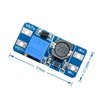I have a 6v vintage car. I want to add a voltmeter under the dash but 6v voltmeters are scarce. So I thought to add a voltage doubler inline before the gauge and adjust the gauge for any voltage loss. I’ve built a voltage doubler with a 555 chip and some bits and pieces. The doubler seems to work perfect on the bench with my multimeter. With a 6v battery and the doubler, the multimeter reads 11.5v. With a 9v battery and the doubler, the multimeter reads 17v. The car has a 6v generator and puts out around 7v which measures 12v with the doubler and using the multimeter.
Using the VDO gauge I get unexpected results. Not using the doubler, VDO reads the voltage correctly, 12v battery reads 12v. 9v battery reads 9v. However when using the doubler I get very low results. 6v battery and doubler read 8. 9v battery and doubler reads 11v. So my 7v car generator doesn’t barely register on the VDO which starts at 8v. So... why does the doubler show different results between the multimeter and the VDO gauge?
Using the VDO gauge I get unexpected results. Not using the doubler, VDO reads the voltage correctly, 12v battery reads 12v. 9v battery reads 9v. However when using the doubler I get very low results. 6v battery and doubler read 8. 9v battery and doubler reads 11v. So my 7v car generator doesn’t barely register on the VDO which starts at 8v. So... why does the doubler show different results between the multimeter and the VDO gauge?





